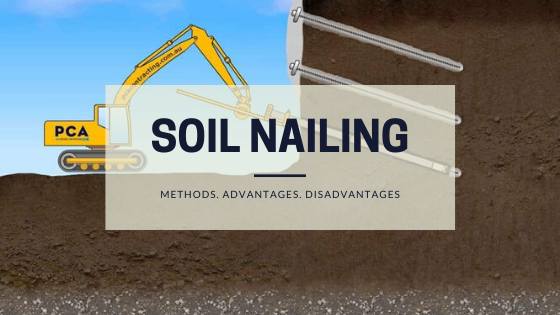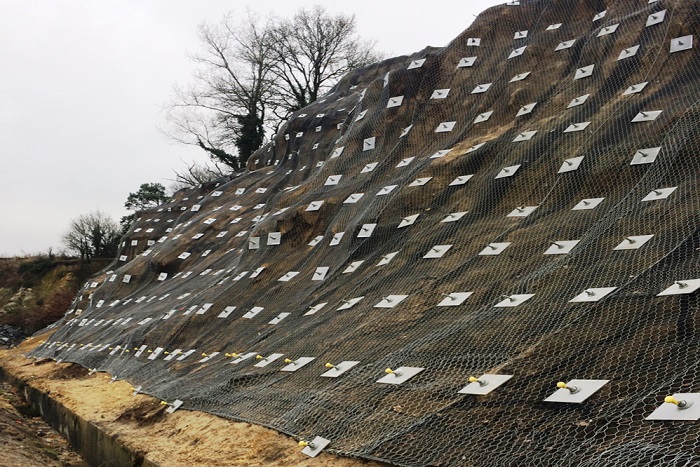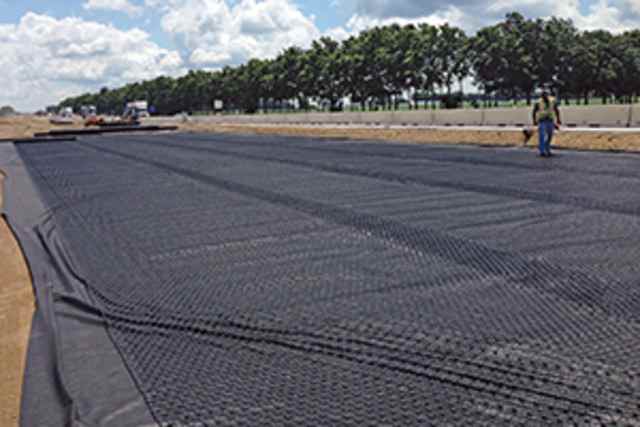
Soil nailing is a technique used to improve the soil and stabilize the slopes. It is used for slopes, excavations, retaining walls etc. to make them stable.
The process of soil nailing consists of reinforcing the natural ground with closely spaced steel or metal bars or section grouted in the pre-drilled holes and providing front face support.
It is called soil nailing because it is similar to have a nail being hammered into the soil where the nails are the steel bars. Soil nail walls are generally constructed from top to down.
Soil Nailing process
In soil nailing technique, the soil is reinforced with slender elements such as reinforcing bars which are called as nails. The reinforcing bars are installed into pre-drilled holes and then grouted. The nails are installed at an inclination of 10 degrees to 20 degrees with vertical.
As the excavation proceeds, concrete and grouting materials are applied on the excavation face to grout the nails and reinforcing steel.
Methods of Soil Nailing
Driven soil nailing method
Driven soil nailing method is used for temporary soil slope stabilization. It does not provide corrosion protection to nails and reinforcement steel. In this method, nails are driven in the slope face during excavation. It is considerably fast. The diameter of the nail is approximately 19 mm to 25 mm and the nail spacing is about 1m to 1.2 m.
Grouted soil nailing method
In this method, the holes are drilled in slope face and walls. Nails are then inserted in the holes and after that holes are filled with grouting materials like concrete, shotcrete etc. The diameter of nails ranges from 100 mm to 200mm and spacing between nails are 1.5 m.
Launched soil nailing method
In this method, steel bars are forced into the soil with a shot using compressed air mechanism. The control over the length of bar penetrating the ground is difficult. The installation is fast. The nail diameter is about 38mm and length is 6m.
Self-drilling soil nailing method
In this method, bars are drilled into the slope surface and grout is injected simultaneously at the time of drilling. Hollow bars are used in this method. This method is faster than drilled grouted nailing method. It provides more corrosion resistance to nails in comparison to driven nails method.
Jet grouted soil nailing method
In this method, jets are used for eroding the soil to create a hole in the slope surface and then steel bars are installed in the hole and grouted it with concrete. It provides good corrosion protection for steel bars and nails.
Soil Nail installation considerations
- Soil Nails should be penetrated into the passive zone typically for 4 to 5 m beyond the slip plane.
- The spacing of soil nails in the horizontal or vertical direction must be related to the strength of the soil. Extra soil nails should be installed at the edge of the surface to stabilize it.
- Soil nailing should start immediately after excavation and delay may lead to the collapse of soil slope.
Advantages of Soil Nailing
- It is used for confined spaces with restricted access.
- It can be used on new construction, temporary structures, remodelling process as well as to repairs the existing wall system.
- This technique is flexible, relatively quick and easy to install.
- It is a time-saving and cost-saving method.
- It requires less labour.
- No harmful impact on the environment.
- There is a restriction on wall height.
- It uses fewer materials and minimum shoring.
Disadvantages of Soil Nailing
- The metal nail will corrode.
- Not suitable for use in areas of the high water table.
- The soil might be overexposed prior to the installation of a nail.
- Not recommended for permanent long term application in sensitive and expansive soil.
- Requires specialized and experienced contractors.
- Sand and gravels might not be compatible with soil technique.
- In soils of low shear strength, very high soil density may be required.
Applications of Soil Nailing
The soil nailing process has applications in the following fields:
- Roadway cuts.
- Tunnel portals
- Underbridge abutments.
- Slope stabilization
- Repair and reconstruction of existing retaining structures.
- Temporary excavation shoring.
- Steep cutting stabilizations
- Landslide redemption
- Stabilization of existing retaining wall
- Stabilizing of over steep existing embankments.
Also Read: Soil-Cement



Like!! Thank you for publishing this awesome article.